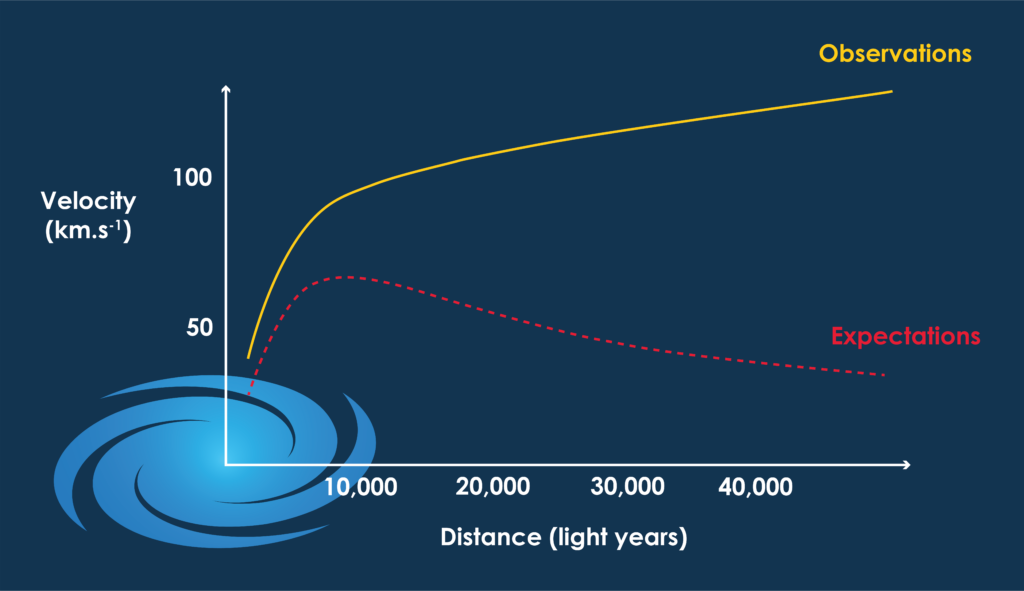Dark Matter is not one of the powerful sith lord in the Universe, but is one of the biggest mysteries in astrophysics. It refers to a transparent form of matter that does not interact with light, making it invisible to our telescopes. Nevertheless its presence can be inferred through its gravitational effects on usual visible matter and the large-scale structure of the Universe.
There is a lot of observational evidence for dark matter that has accumulated for decades. According to this, the Universe is made of around 27% of this strange kind of matter while common matter accounts for only 5% (the rest is dark energy). This means that dark matter is much more abundant than the familiar matter that we can see in our daily life: the stars, planets, people or your screen.
What are these different bits of evidence? The first for its existence comes from the study of galactic rotation curves. When astronomers measure the rotational velocities of stars and gas clouds that rotate around a galaxy’s center, they find that these objects move much faster than expected based on the visible matter alone. Faster motion implies more matter inside their orbit that excerts a gravitational pull. But there is simply not enought mass, when adding up just the ‘normal’ matter, to explain the observed velocities.

Gravitational lensing provides another hint for dark matter. The bending of light by the gravitational pull of massive objects – galaxies or galaxy clusters – again suggests the presence of much more mass than visible. These observations indicate that there must be a lot of unseen matter contributing to the gravitational, space-bending forces at work.
What is dark matter then? Scientists have proposed several candidate particles that could potentially make up dark matter. One prominent candidate is the family of Weakly Interacting Massive Particles (WIMPs). WIMPs are, so far, hypothetical particles that would interact mostly through gravity and weak nuclear forces but only very weakly, if at all, through the electromagnetic force. If WIMPs exist, they could have been produced in the early Universe and still exist today, making up the bulk of dark matter.
Credits: NASA/Goddard Space Flight Center
Axions are another class of hypothetical particles that could explain dark matter and that were originally proposed to solve another physics problem known as the ‘strong CP problem’. Axions are extremely light and the theories that predict them are connected to inflation scenarios of the early universe, providing them with properties that make them excellent dark matter candidates. While at this time there is no direct experimental proof for axions, ongoing projects – both in the lab as well as through astrophysical observations, are trying to use their conversion from and to energetic photons aim to detect them and confirm their existence.
Moreover, a few theories suggest that dark matter could be made of even more weakly interacting particles, like for example a fourth neutrino called ‘sterile neutrino’. These particles would be even harder to detect in physics experiments than axions or WIMPs, but are still interesting possibilities to explore.
So, dark matter is definitely a particle? Actually we don’t know! Alternative theories have been proposed to explain this strange kind of matter or behaviour of gravitational attraction. One such theory is the so-called ‘Modified Newtonian Dynamics’ (MOND), which suggests that the laws of gravity might be different on large scales. With experiments on Earth or the solar system, we can directly probe only scales that are a billion times smaller than seen for the rotation curves of galaxies for example. According to MOND, the observed discrepancies in galactic rotation curves would be explained by a modification of gravity, rather than the presence of a new type of matter. However, the debate is still active within the science community about this theory, and further observations are needed to test this idea.
Today, dark matter remains an enigmatic component of the Universe. Euclid will in fact not only search for dark matter, but will actually be testing the nature of gravity, including potential modifications as MOND. So what is dark matter? We will try to find out.



